Redhill
General Hospital
Pendleton Road, Earlswood Common,
Redhill, Surrey
RH1 6LA
Medical
dates:
Medical
character:
Acute
In 1793 the Reigate Poor Law
Union built a workhouse on 10 acres of Earlswood Common. It
opened in 1794 to provide accommodation for the poor and destitute,
many of whom were old and infirm.
In 1865 a detached infirmary block was added.
During WW1, in 1915-16, a new infirmary was built on the eastern part of the site.
In May 1917 the Army Council requisitioned the new building and, in the following month, it became the Redhill War Hospital.
The War Hospital was officially opened on 20th June by Lord Ashcombe, the Lord-Lieutenant of Surrey, and Lady Ashcombe. It was affiliated to Croydon War Hospital and had 80 beds for wounded and sick servicemen, an operating theatre, an X-ray Department and a Massage Department. It was staffed by members of the Surrey/108 Voluntary Aid Detachment. On 3rd July 1917 the Hospital received its first convoy of wounded.
It became a first-line hospital, receiving the wounded direct from overseas.
The War Hospital closed on 31st December 1918. However, a curative post (out-patients clinic) opened the following day, on 1st January 1919. It was established by a Mrs Lemon of the British Red Cross Society at the request of the Ministry of Pensions to provide continuing care for discharged soldiers still in need of medical treatment. The clinic provided a change of dressings for unhealed wounds or sores, attention to minor ailments of the eyes, ears, throat, etc, and massage, exercise and electrical treatments - galvanism, faradism, radiant heat - for injured limbs.
In 1930, following the abolition of the Boards of Guardians, the workhouse and its infirmary came under the control of Surrey County Council. They were renamed the Redhill Public Assistance Institution (P.A.I.).
In October 1936 the County Council decided to convert the Institution into a general hospital. By 1938 the chronically sick inmates of the P.A.I. had been transferred to St Anne's Home for the Aged in Redhill, while the former workhouse and its infirmary had become the Surrey County Hospital, later changed to Redhill County Hospital (confusingly there was also a Redhill County Hospital at Edgware, Middlesex).
New buildings were erected and the wards were named after towns in Surrey - for example, the surgical wards were Bramley and Brockham, while the medical ones were Chaldon and Chipstead; the isolation unit was Ifield Ward.
In 1948 the Hospital joined the NHS as the Redhill General Hospital, under the auspices of the Redhill Group Hospital Management Committee, part of the South West Metropolitan Regional Hospital Board. Because facilities on the site were so inadequate, in the following year the Hospital was merged with Smallfield Hospital. The bed complement for both sites was 576. The ambulance station was moved to Smallfield Hospital.
With a view to future expansion of the Hospital, in 1949 Earlswood Mount- a large mansion with extensive grounds adjacent to the western side of the Hospital - was purchased.
In 1952 the main kitchen was improved and two cottages at Earlswood Mount renovated for the use of staff. The Hospital, together with its Smallfield site, had 576 beds, of which 445 were staffed.
During the 1960s the orthopaedic surgeon Mr Peter Ring developed one of the earliest uncemented prostheses for hip joint replacement (the Ring prosthesis was manufactured and marketed from 1964 by Downs Surgical Ltd of Mitcham).
In 1964, following amalgamation of the Redhill and Netherne Groups, the Hospital was managed by the Redhill and Netherne Group Hospital Management Committee, which had its offices in Earlswood Mount from 1968 to 1975.
In 1969, when on average daily the Hospital (between both its sites) had 391 patients, 219 resident staff and 88 non-resident, the cost of food for each person was estimated to be 38s 3d (£1.91) a week.
In June 1972 a new orthopaedic Out-Patients Department opened.
In 1974, following a major reorganisation of the NHS, the Hospital came under the control of the East Surrey District Health Authority, part of the South West Thames Regional Health Authority.
As the Hospital was one of the nearest to Gatwick Airport and the M23 - with construction underway for the new M25 - doubt was expressed in Parliament in 1975 about its ability to cope with a major emergency. Its two operating theatres were regarded by the surgeons using them as substandard. The theatres, on different floors, were linked by a non-sterile lift and a public stone stairway. Work had begun on a new theatre, but the logistic problem remained that surgeons operated on 'cold' cases at Smallfield, eight miles away, while emergency surgery was undertaken at the Redhill site. The Hospital also housed the District's blood bank and pathology laboratories, but both departments were cramped. To reach chemicals stored on the top shelves, it was necessary to climb over those stored on the floor; on one occasion these were piled up to the ceiling in the gents' WC. It was feared that too many services were near to breakdown.
After many delays to the project, building work finally began in 1979 on a replacement district general hospital southeast of the site, the first phase of which was due to be finished in the early 1980s.
At the beginning of the 1980s, despite being unable to expand, the Hospital absorbed the services and facilities from the East Surrey Hospital, which closed in 1983.
At the beginning of 1983 the Hospital and its Smallfield site had 414 acute beds. However, Smallfield Hospital closed at the end of the year, with services moving to the New East Surrey Hospital.
In 1990 the Hospital had 230 beds.
It closed in 1991 when the second phase of the new East Surrey Hospital opened, with services moving to the new site.
Present status (November 2009)
In 1865 a detached infirmary block was added.
During WW1, in 1915-16, a new infirmary was built on the eastern part of the site.
In May 1917 the Army Council requisitioned the new building and, in the following month, it became the Redhill War Hospital.
The War Hospital was officially opened on 20th June by Lord Ashcombe, the Lord-Lieutenant of Surrey, and Lady Ashcombe. It was affiliated to Croydon War Hospital and had 80 beds for wounded and sick servicemen, an operating theatre, an X-ray Department and a Massage Department. It was staffed by members of the Surrey/108 Voluntary Aid Detachment. On 3rd July 1917 the Hospital received its first convoy of wounded.
It became a first-line hospital, receiving the wounded direct from overseas.
The War Hospital closed on 31st December 1918. However, a curative post (out-patients clinic) opened the following day, on 1st January 1919. It was established by a Mrs Lemon of the British Red Cross Society at the request of the Ministry of Pensions to provide continuing care for discharged soldiers still in need of medical treatment. The clinic provided a change of dressings for unhealed wounds or sores, attention to minor ailments of the eyes, ears, throat, etc, and massage, exercise and electrical treatments - galvanism, faradism, radiant heat - for injured limbs.
In 1930, following the abolition of the Boards of Guardians, the workhouse and its infirmary came under the control of Surrey County Council. They were renamed the Redhill Public Assistance Institution (P.A.I.).
In October 1936 the County Council decided to convert the Institution into a general hospital. By 1938 the chronically sick inmates of the P.A.I. had been transferred to St Anne's Home for the Aged in Redhill, while the former workhouse and its infirmary had become the Surrey County Hospital, later changed to Redhill County Hospital (confusingly there was also a Redhill County Hospital at Edgware, Middlesex).
New buildings were erected and the wards were named after towns in Surrey - for example, the surgical wards were Bramley and Brockham, while the medical ones were Chaldon and Chipstead; the isolation unit was Ifield Ward.
In 1948 the Hospital joined the NHS as the Redhill General Hospital, under the auspices of the Redhill Group Hospital Management Committee, part of the South West Metropolitan Regional Hospital Board. Because facilities on the site were so inadequate, in the following year the Hospital was merged with Smallfield Hospital. The bed complement for both sites was 576. The ambulance station was moved to Smallfield Hospital.
With a view to future expansion of the Hospital, in 1949 Earlswood Mount- a large mansion with extensive grounds adjacent to the western side of the Hospital - was purchased.
In 1952 the main kitchen was improved and two cottages at Earlswood Mount renovated for the use of staff. The Hospital, together with its Smallfield site, had 576 beds, of which 445 were staffed.
During the 1960s the orthopaedic surgeon Mr Peter Ring developed one of the earliest uncemented prostheses for hip joint replacement (the Ring prosthesis was manufactured and marketed from 1964 by Downs Surgical Ltd of Mitcham).
In 1964, following amalgamation of the Redhill and Netherne Groups, the Hospital was managed by the Redhill and Netherne Group Hospital Management Committee, which had its offices in Earlswood Mount from 1968 to 1975.
In 1969, when on average daily the Hospital (between both its sites) had 391 patients, 219 resident staff and 88 non-resident, the cost of food for each person was estimated to be 38s 3d (£1.91) a week.
In June 1972 a new orthopaedic Out-Patients Department opened.
In 1974, following a major reorganisation of the NHS, the Hospital came under the control of the East Surrey District Health Authority, part of the South West Thames Regional Health Authority.
As the Hospital was one of the nearest to Gatwick Airport and the M23 - with construction underway for the new M25 - doubt was expressed in Parliament in 1975 about its ability to cope with a major emergency. Its two operating theatres were regarded by the surgeons using them as substandard. The theatres, on different floors, were linked by a non-sterile lift and a public stone stairway. Work had begun on a new theatre, but the logistic problem remained that surgeons operated on 'cold' cases at Smallfield, eight miles away, while emergency surgery was undertaken at the Redhill site. The Hospital also housed the District's blood bank and pathology laboratories, but both departments were cramped. To reach chemicals stored on the top shelves, it was necessary to climb over those stored on the floor; on one occasion these were piled up to the ceiling in the gents' WC. It was feared that too many services were near to breakdown.
After many delays to the project, building work finally began in 1979 on a replacement district general hospital southeast of the site, the first phase of which was due to be finished in the early 1980s.
At the beginning of the 1980s, despite being unable to expand, the Hospital absorbed the services and facilities from the East Surrey Hospital, which closed in 1983.
At the beginning of 1983 the Hospital and its Smallfield site had 414 acute beds. However, Smallfield Hospital closed at the end of the year, with services moving to the New East Surrey Hospital.
In 1990 the Hospital had 230 beds.
It closed in 1991 when the second phase of the new East Surrey Hospital opened, with services moving to the new site.
Present status (November 2009)
In 1995 many of the Hospital buildings were demolished and the site was redeveloped as the St John's Park estate by Linden Homes. New homes were built and a new road - Abinger Drive.
Some former Hospital buildings, however, have survived, including the Porter's Lodge and Sherwood House by the entrance.
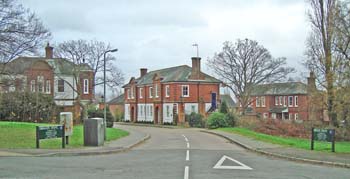
The entrance to Abinger Drive, off Pendleton Road, with the Porter's Lodge on the left and Sherwood House in the centre of the image.
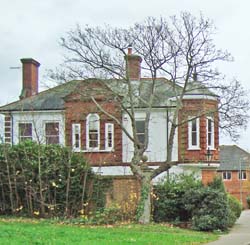
The rather handsome Porter's Lodge.
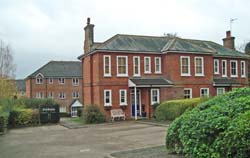
A few of the original Hospital buildings have been converted into residences (above and below).
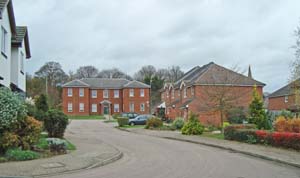
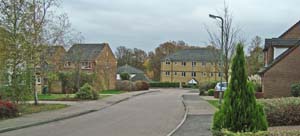
New housing has been built in the centre of the site.
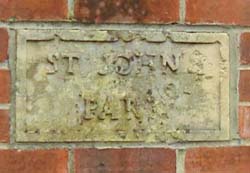
Signage for St John's Park, now barely readable.
(Author unstated (1917 List of the various hospitals treating military cases in the United Kingdom. London, H.M.S.O.
(Author unstated) 1920 Red Cross work in Surrey 1918-1919. British Red Cross Society Surrey Branch.
Ring PA 1968 Complete replacement arthroplasty of the hip by the Ring prosthesis. Journal of Bone and Joint Surgery 50-B, 720-731.
http://dev.francisfrith.com
http://edithsstreets.blogspot.co.uk
http://hansard.millbanksystems.com (1)
http://hansard.millbanksystems.com (2)
www.britishpathe.com
www.exploringsurreyspast.org.uk
www.flickr.com (1)
www.flickr.com (2)
www.francisfrith.com (1)
www.francisfrith.com (2)
www.geograph.org.uk
www.kentvad.org
www.redhill-reigate-history.co.uk(1)
www.redhill-reigate-history.co.uk (2)
www.redhillandreigatelife.co.uk
www.reigatehistory.co.uk
www.sashlibrary.nhs.uk
www.scarletfinders.co.uk
www.workhouses.org.uk
Return to home page